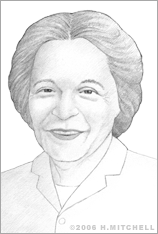Maria Telkes
For centuries human beings have attempted to capture and direct for a variety of specific uses the incredible natural energy radiated from the sun. This heavenly body provides, according to a generally accepted standard, approximately 1,000 watts per meter squared at sea level; the trick is in harnessing and targeting it in the place desired for it to be able to accomplish specific tasks.
Maria Telkes devoted her career to this very endeavor, inventing in the process one of the first successful solar ovens, solar heating systems, and a solar water distilling system for making seawater potable. Born in Budapest, Hungary, on Dec. 12, 1900, she became interested in solar energy while still in high school, and entered the University of Budapest where she completed a BA in physical chemistry in 1920, followed by a PhD in the subject in 1924.
Telkes, who would later become known as the “Sun Queen,” emigrated to the United States in 1925 to work as a biophysicist for the Cleveland Clinic Foundation. There she conducted research related to life-transformative energy. She stayed there until 1937, when she became an American citizen, after which she joined Westinghouse Electric as a research engineer in the area of energy conversion, in this case, converting heat energy into electric energy.
In 1940, Telkes began a partnership with the Massachusetts Institute of Technology, joining the university’s Solar Energy Conversion Project. Her involvement with this project would put her on a fifty-year path to developing innovative new processes for capturing and deploying solar energy. She became an associate research professor with MIT in 1945 in the field of metallurgy.
While working with MIT she designed a solar heating system for the Dover House, an experimental home designed to showcase the power of solar energy, built in 1948, designed by architect Eleanor Raymond and sponsored by Amelia Peabody. Telkes’ system was able to capture and store solar energy which was then distributed by fans as needed. Her storage process relied on chemistry; she developed a process whereby solar-generated energy could be stored chemically through the crystallization of a sodium sulfate solution.
In addition to this work, Telkes was awarded a $45,000 grant from the Ford Foundation to work on a solar oven. Her oven was to be used by individuals in any country of the world, to prepare any type of cuisine, and to be safe enough to be used by children. In the process of inventing this oven, she also developed a faster way for farmers to dry their crops.
She was also called upon by the U.S. government’s Office of Scientific Research and Development during World War II to help develop a solar still for converting seawater into fresh water, which she accomplished by creating a portable water evaporator. This device made it possible to remove salt from seawater by vaporizing it, then recooling it into potable water. This scalable system could be taken on a small life raft, or made large enough to supply fresh water to entire cities. Her portable survival still was able to provide up to one quart of fresh water per day.
In 1953, a year after she won the first-ever Society of Women Engineers Achievement Award, Telkes moved on to the New York University College of Engineering where she established a laboratory dedicated to solar energy research. From there she returned to industry, joining the Curtiss-Wright Company as director of the firm’s solar energy laboratory. She moved on to Cryo-Therm, working on space and sea-proof materials from 1961 to 1963 before moving on to Melpar, Inc., where she served as director of the company’s solar energy laboratory until 1969. At that time Telkes returned to academia as a researcher at the University of Delaware’s Institute of Energy Conversion.
In 1977, Telkes was recognized as one of the world’s foremost pioneers in the field of solar energy when she was honored with the Charles Greeley Abbot Award granted by the American Section of the International Solar Energy Society. The oil crisis on the 1970s spurred a great deal of interest in solar energy, which lead to the construction of a second experimental solar-heated house, the Carlisle House, with which Telkes was involved in 1980. Telkes, who earned some 20 patents over the course of her career, continued her affiliation with the University of Delaware and served as a consultant to a variety of companies and organizations around the world until her death at the age of 94. She died in her native Budapest on December 2, 1995.


